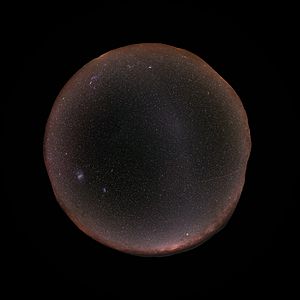Gegenschein facts for kids
The Gegenschein, also known as the Counterglow, is a very faint patch of light you can sometimes see in the night sky. It looks like a soft, glowing oval. This light appears in the part of the sky that is exactly opposite to where the Sun is. It's super hard to spot because it's so dim! You can only see it if you are far away from cities and their bright lights, and on nights when there is no moon in the sky. The Gegenschein happens because tiny bits of matter (like dust) floating in space reflect the Sun's light back towards Earth. It's related to something called the zodiacal light, which is another faint glow caused by similar space dust closer to the Sun.

Contents
What causes the Gegenschein?
The Gegenschein is caused by sunlight reflecting off countless tiny dust particles. These dust particles are spread out in space, mostly in the plane of Earth's orbit around the Sun. When the Sun's light hits these dust particles, they scatter the light in all directions.
Dust in space
The dust particles that cause the Gegenschein are very small. They are often leftover bits from comets or asteroids. These tiny pieces of rock and ice drift through space. When they are directly opposite the Sun from Earth's point of view, they reflect a lot of sunlight back to us. This creates the faint glow we call the Gegenschein.
Connection to zodiacal light
The Gegenschein is part of a larger phenomenon called the zodiacal light. The zodiacal light is a cone-shaped glow seen along the ecliptic (the path the Sun appears to follow). It's also caused by sunlight reflecting off space dust. The Gegenschein is like a brighter, more concentrated spot within this wider band of zodiacal light. It's brighter because of a special effect called "backscatter." This means the dust particles reflect light more strongly when the light source (the Sun) is directly behind the observer (you on Earth).
How to see the Gegenschein
Seeing the Gegenschein is a real challenge for stargazers. It's one of the faintest objects in the night sky.
Best viewing conditions
To have any chance of spotting the Gegenschein, you need very specific conditions:
- Dark skies: You must be far away from any light pollution. This means getting away from cities, towns, and even streetlights.
- No moon: The Moon's light is too bright and will easily hide the faint glow of the Gegenschein. You need a night when the Moon is not visible or is a very thin crescent.
- Clear weather: There should be no clouds, haze, or fog in the sky.
- Time of year: The Gegenschein is usually easiest to see in the late summer and early autumn in the Northern Hemisphere. This is because the Milky Way, which can also be a source of light, is lower in the sky during these months.
Looking for the glow
To find the Gegenschein, you need to know where the Sun is in the sky, even though it's nighttime. The Gegenschein will be in the exact opposite direction. For example, if the Sun set in the west, the Gegenschein will be in the eastern sky. It will appear as a very subtle, oval-shaped glow. It's often best seen by looking slightly away from it, using your peripheral vision, as our eyes are more sensitive to faint light this way.
Images for kids
-
The gegenschein appears in this image as a bright spot on the diagonal band (running top left to lower right) above the Very Large Telescope. (The Andromeda Galaxy and Pleiades are prominent in the lower half of the image.)
See also
 In Spanish: Gegenschein para niños
In Spanish: Gegenschein para niños


